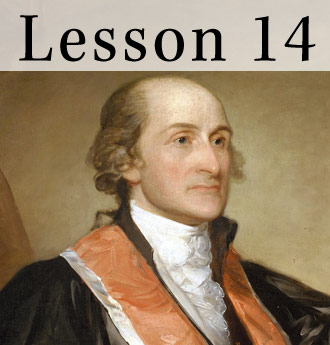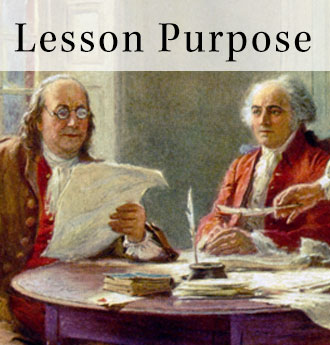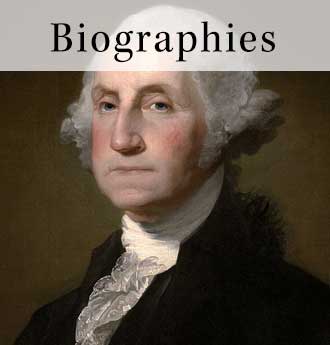Lesson 14: What Was the Federalist Position in the Debate about Ratification?
The Federalist Papers
A collection of eighty-five essays advocating the ratification of the constitution proposed at the Philadelphia Convention, properly called The Federalist, written between October, 1787 and May, 1788 by James Madison, Alexander Hamilton, and John Jay.
Link: http://thomas.loc.gov/home/histdox/fedpapers.html
Alexander Hamilton, The Examination #12
Hamilton's thoughts on Article 3, Section 1 of the Constitution: "The judicial Power of the United States, shall be vested in one supreme Court, and in such inferior Courts as the Congress may from time to time ordain and establish."
Link: http://bit.ly/2oSOfU
Benjamin Franklin's Speech to the Constitutional Convention
Franklin's speech, delivered by James Wilson, in favor of the new Constitution, despite its possible faults.
Link: http://www.usconstitution.net/franklin.html
Bill of Rights (1791): The original 12 proposed amendments
James Madison originally submitted 17 amendments to become the Bill of RIghts. All were passed by the House of Representatives, but only 12 were passed by the Senate and the states ratified 10 of them.
Link: http://www.constitution.org/billofr_.htm
Centinel No. 11
Anti-Federalist paper published in the Philadelphia Independent Gazetteer and Philadelphia Freeman's Journal, arguing that people a fear or anarchy is not enough reason to justify ratifying the Constitution.
Link: http://bit.ly/1gyTxL
Federalist No. 1
From WIkipedia: Federalist No. 1 is an essay by Alexander Hamilton and the first of the Federalist Papers, a preface in broad terms of the forthcoming arguments in favor of the proposed constitution.
Link: http://www.constitution.org/fed/federa01.htm
Federalist No. 10
From Wikipedia: Federalist No. 10 is an essay by James Madison arguing for the ratification of the United States Constitution. It addresses the question of how to guard against "factions" with interests contrary to the rights of others or the interests of the whole community.
Link: http://www.constitution.org/fed/federa10.htm
Federalist No. 14
From Wikipedia: Federalist No. 14 is an essay titled, "Objections to the Proposed Constitution From Extent of Territory Answered" by James Madison addressing a major objection of the Anti-Federalists to the proposed Constitution: that the sheer size of the United States would make it impossible to govern justly as a single country.
Link: http://www.constitution.org/fed/federa14.htm
Federalist No. 34
From Wikipedia: Hamilton's aim is to demonstrate that a government must have unlimited power of taxation for such circumstances as war and natural disaster.
Link: http://www.constitution.org/fed/federa34.htm
Federalist No. 37
From Wikipedia: Federalist No. 37 is an essay by James Madison, published on January 11, 1788 discussing some of the political questions raised at the Constitutional Convention, such as the question of the authority of the state versus the liberty of the people.
Link: http://avalon.law.yale.edu/18th_century/fed37.asp
Federalist No. 39
From Wikipedia: In No. 39, James Madison argues that the operation of the government will be republican but the principles of that operation will be democratic.
Link: http://www.constitution.org/fed/federa39.htm
Federalist No. 42
From Wikipedia: Federalist No. 42 is an essay by James Madison, contending that the grant of specific powers to the federal government actually operates to limit the power of the federal government to act with respect to the states.
Link: http://www.constitution.org/fed/federa42.htm
Federalist No. 43
Federalist No. 43, written by James Madison and titled, ""The Same Subject Continued: The Powers Conferred by the Constitution Further Considered," continues Federalist No. 42 on ratification.
Link: http://avalon.law.yale.edu/18th_century/fed43.asp
Federalist No. 45
Federalist No. 45 was written by James Madison and published January 26, 1788 and addresses the concern of balancing the power between federal and state governments.
Link: http://avalon.law.yale.edu/18th_century/fed45.asp
Federalist No. 47
Federalist No. 47 was written by James Madison and addresses concerns that the proposed constitution did not provide enough separation of powers.
Link: http://avalon.law.yale.edu/18th_century/fed47.asp
Federalist No. 48
From Wikipedia: Federalist No. 48 is an essay by James Madison, building on Federalist No. 47 in which Madison argued for separation of powers; in this one he argues that the legislative, executive, and judicial branches of government must not be totally divided.
Link: http://avalon.law.yale.edu/18th_century/fed48.asp
Federalist No. 51
From Wikipedia: Federalist No. 51 is an essay by James Madison, published on February 6, 1788. No. 51 addresses means by which appropriate checks and balances can be created in government.
Link: http://avalon.law.yale.edu/18th_century/fed51.asp
Federalist No. 68
Federalist No. 68 was written by Alexander Hamilton and discusses the process of electing the president and vice president.
Link: http://avalon.law.yale.edu/18th_century/fed68.asp
Federalist No. 70
Federalist No. 70 was written by Alexander Hamilton and examines the question of a plural executive, arguing that having multiple presidents introduces conflict and difference of opinion.
Link: http://avalon.law.yale.edu/18th_century/fed70.asp
Federalist No. 78
From Wikipedia: The essay was published May 28, 1788 and was written to explicate and justify the structure of the judiciary under the proposed Constitution; it is the first of six essays by Hamilton on this issue. In particular, it addresses concerns by the Anti-Federalists over the scope and power of the federal judiciary, which would have comprised unelected, politically insulated judges that would be appointed for life.
Link: http://www.constitution.org/fed/federa78.htm
Federalist No. 8
From Wikipedia: In this paper, Hamilton argues for the utility of the Union to the well-being of Americans, specifically addressing the negative consequences if the Union were to collapse and conflict arise between the states. It is titled, "Consequences of Hostilities Between the States."
Link: http://www.constitution.org/fed/federa08.htm
Federalist No. 84
From Wikipedia: Federalist No. 84, titled, "Certain General and Miscellaneous Objections to the Constitution Considered and Answered," was written by Alexander Hamilton and asserted that the Bill of RIghts was not a necessary component of the proposed constitution.
Link: http://www.constitution.org/fed/federa84.htm
Fisher Ames, Speech at the Massachusetts Ratifying Convention
At the Massachusetts state convention of 1788, Ames's persuasive oratory was influential in obtaining ratification of the federal Constitution.
Link: http://tinyurl.com/yz2f4za
Luther Martin: Address No. 4
Martin's letter to the citizens of Maryland warning of entrusting too much power to the government.
Link: http://bit.ly/bDQYl
Luther Martin: Genuine Information No. 12 (1788)
Martin's extensive criticism of the Philadelphia Convention, its methods and its work.
Link: http://bit.ly/146y0y
United States Bill of Rights
From Wikipedia: In the United States, the Bill of Rights is the name by which the first ten amendments to the U.S. Constitution are known. They were introduced by James Madison to the First United States Congress in 1789 as a series of articles, and came into effect on December 15, 1791, when they had been ratified by three quarters of the states.
Link: http://www.constitution.org/billofr_.htm
United States Constitution
The supreme law of the United States that provides the framework for the government. The Constitution outlines the nation's institutions of government and the most important rights of the people. The document was created in 1787 during the Philadelphia Convention. The government created by the Constitution took effect on March 4, 1789.
Link: http://civiced.org/constitution






